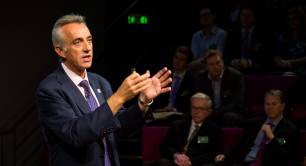Corporate social storytelling puts pressure on non-profits
Pressure on the non-profit sector to deliver effective social impact storytelling is increasing as more and more corporates seek to strengthen their brands using similar communications techniques and messaging.
This was the premise behind a session led by Karen Armstrong, former director of marketing and fundraising at Cancer Council Australia, at the 2015 International Fundraising Congress in Amsterdam this week.
“Corporate Social Responsibility (CSR) is nothing new but it is certainly increasing and the way businesses are tackling CSR is changing. On top of this, to me, social enterprise is the movement that’s definitely going to increase at a phenomenal rate in the next decade or two,” said Armstrong.
According to a survey by Aesop and OnePoll in 2014, Apple, Cadbury and McDonald’s were considered the top three storytelling brands. This may not come as a surprise, with highly memorable advertising campaigns such as Apple’s “Here’s to the crazy ones”, which features civil rights activist Martin Luther King amongst other crusaders of social justice.
However, it is not just these now well-established household names using the same language around creating positive social change that non-profits traditionally have. Take the fast food burrito company Chipotle for example – its brand messaging includes the lines:
“We’re committed because we understand the connection between how food is raised and prepared and how it tastes. With every burrito we roll or bowl we fill, we’re working to cultivate a better world.”
After showing the company’s emotive animated advert, Armstrong asked: “How does somebody understand what is different about what the nonprofit sector can build versus what a really good CSR strategy could deliver within the commercial sector or what social enterprises can deliver? If we don’t partner is that going to lock us out and prevent us from being able to influence commercial organisations?"
While it is clear traditional non-profit organisations have a vital role to play in providing solutions to the many social and environmental challenges facing the world, the emergence of socially driven marketing strategies certainly creates a predicament around how they need to present themselves to the public.
Armstrong said: “This is where consumers are really struggling to differentiate where they can have the biggest impact, because when we look at what needs are being fulfilled, and if they can be fulfilled in an easier or different type of exchange that they can have with a commercial organisation, then why would they need to experience that with the non-profit sector?”
Often referred to as global leaders in CSR is Unilever. Its Project Sunlight focuses on teaching people about the importance of hygiene and sanitation – in basic terms washing your hands. On the project’s website page it reads, “Help every child celebrate their 5th birthday”, followed by a box encouraging people to a box urging readers to share the moving film to be found there. Both the messaging and data collection method mirror those of traditional nonprofits.
This transition in marketing provokes the bigger debate around what sort of relationships, if any, the non-profit sector should be developing with these corporates. After being shown Unilever’s website, one audience member stated: “Isn’t that just wrong and a lie because that soap has no better qualities than any other soap. It is a total lie. This is all just to sell more products surely.”
In response another audience member said: “I don’t think it is a lie. Unilever are one of the most forward thinking commercial organisations on the globe and a lot of other commercial organisations could learn a lot from them.”
In the social enterprise sector this argument around profit with purpose and whether it is ethically and morally acceptable to make money by doing good by the planet and its people is no new phenomenon. However in this context of non-profit fundraising the debate seems a lot less tired.
Armstrong added: “It’s a really difficult argument because I think it’s great if commercial organisations are being genuine about helping make positive change, but there is also the reality that at the end of the day of course they have shareholders, a bottom line and all those KPIs they need to hit.
“It raises the interesting question for the non-profit sector; do you or don’t you partner? And how do you keep that true to both organisations? If we don’t partner is that going to lock us out and prevent us from being able to influence commercial organisations?”
In a natural progression from looking at the marketing and communications challenge increased interest in social impact from the private sector provides, conversation briefly touched upon wider issues. Armstrong warned: “Social enterprise is going to start coming in and then there’s the question around what does this mean for our programmes?
“Programmes that could potentially be run profitably then become attractive to the commercial sector and they start to look at how they can operationalise those. It is an interesting shift occurring.”
The non-profit sector simply cannot ignore the change that is being driven around them – by social enterprises, corporates and consumers – even if at times it seems unjust.
Armstrong concluded: “What is totally unfair is that if a commercial organisation does something good, it is applauded. If a not-for-profit uses money for fundraising it’s not always seen as so good for example. People are putting a totally different lens on our sector and the way they think about us. It is really important we work out how to get our trust levels back up.”
Photo credit: Jeff Kubina



